#render roma
Explore tagged Tumblr posts
Photo









RENDERING INTERIOR DESIGN APPARTAMENTO
Sono davvero moltissimi i lavori di rendering per ristrutturazioni di appartamenti che abbiamo realizzato finora, con grande soddisfazione nostra ma soprattutto dei clienti. Grazie a queste significative esperienze abbiamo potuto distinguere due profili che li identificano:
- Chi vuole rinnovare ma non ha delle idee precise riguardo l’arredo o l’organizzazione degli ambienti e opta anche per il nostro contributo “creativo” per poi rivedere eventuali modifiche insieme.
- Chi ha già una visione chiara e cerca sul web delle ispirazioni da proporci.
La cliente per la quale abbiamo realizzato questo lavoro corrisponde proprio a questa seconda descrizione: ci ha richiesto infatti due versioni distinte dei render camera matrimoniale, dei render bagno e dei render cameretta. Perché a volte si sa già quale direzione prendere, ma allo stesso tempo si è in bilico fra due possibili scelte.
Inoltre tali soluzioni contemplavano, per camera padronale e cameretta, mobili esistenti che la cliente era intenzionata ad acquistare. Sono tante le aziende che sui loro siti riportano le misure esatte dei loro prodotti, il che ci facilita molto nell’appurare la corrispondenza fra lo spazio disponibile e l’ingombro del mobilio richiesto. Proprio per questo abbiamo riprodotto fedelmente il modello sia nelle misure che nei materiali. Così è stato dunque possibile controllare se la composizione fosse da rimodulare e quale fosse la versione più idonea anche esteticamente parlando.
Per quanto riguarda il render camera studio, invece, abbiamo seguito delle immagini di ispirazione dal web selezionate dalla cliente.
Per i due render bagno, infine, le indicazioni erano ben delineate: piastrelle effetto carta da parati con motivo floreale, doccia attrezzata per cromoterapia e portasciugamani di design. Delle scelte audaci, queste, che spesso una volta concretizzate possono non risultare esattamente come le avevamo in mente. Per questo ci siamo noi! Ma anche il vostro aiuto è fondamentale: più le planimetrie che ci fornite sono accurate, più sarà possibile per noi ricreare il tutto in maniera aderente alla realtà.
Per oggi è tutto, ma vi salutiamo con una domanda: voi, a quale profilo appartenete?
Pensateci! Noi intanto vi aspettiamo con l’entusiasmo di sempre su www.stefanomimmocchirendering.com
#interior design#progettazione arredamento d'interni#render#render roma#rendering#rendering appartamento#rendering arredamento#rendering arredamento d'interni#rendering bagno#rendering camera da letto#rendering cameretta bambini#rendering interior design#render interior design appartamento#rendering interni#rendering roma#grafica 3d#studio di grafica roma#stefanomimmocchirendering
0 notes
Text

#Mats Hummels#AS Roma#Serie A#Germany#German footballers#football#soccer#Roma FC#transparent png renders
2 notes
·
View notes
Text
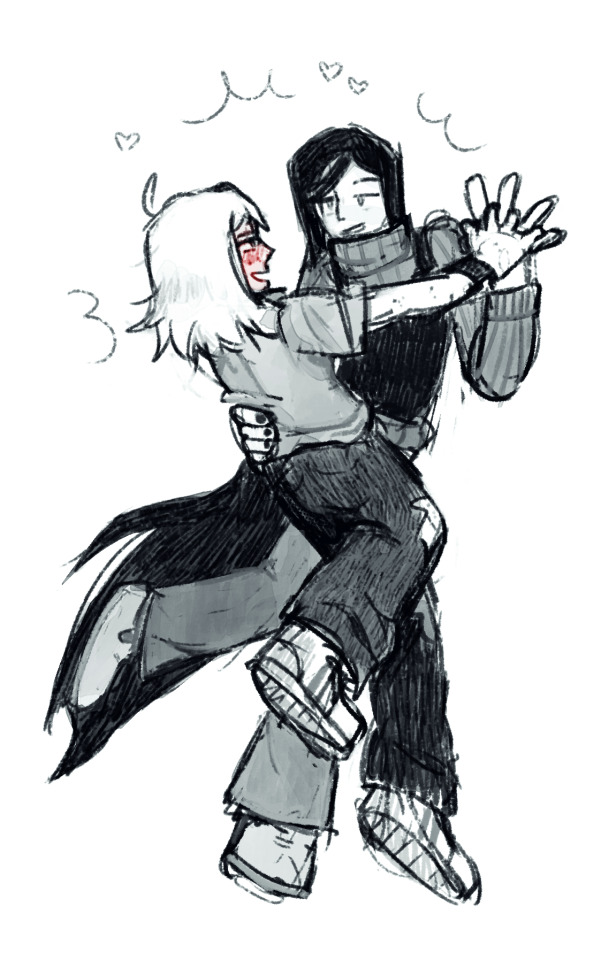
gay people.
kyro belongs to @mayyak
4 notes
·
View notes
Photo



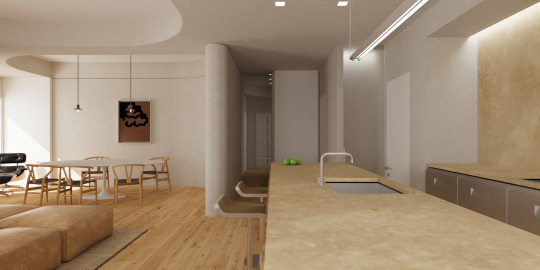






44_apt_Nical
Roma 2023
Ongoing Project
10 notes
·
View notes
Text
i actually do kinda like delivering groceries on the side because it gives me such a unique cross-section of the community. i never know whose groceries im shopping for until i finish the delivery and see them/their home and it's like it adds more detail to the picture of who they are. the baby supplies going to the apartment that i know for a fact is one bedroom (they'll be moving soon - i bet they're apartment hunting, i hope they find a place). the new cat litter box, bowl, and kitten food going to the house covered in "i <3 my dog" paraphernalia (a kitten definitely showed up on the porch recently and made itself at home). the fairly healthy boring grocery order that includes an incongruous tub of candy-filled ice cream going to the home of an elderly woman with toddler toys in the yard (it's clearly for her grandkids, whom she sees often).
shopping for someone else's groceries is a fairly intimate thing. i've bought condoms and pregnancy tests, allergy medicine and nyquil, baby benadryl and teething gel, a huge pile of veggies paired with an equally huge pile of junk food, tampons and shampoo and closet organizers and ant traps and deodorizing shoe inserts and a million other little things that tell a million different stories in their endless combinations. one time someone had me buy one single green bean. i messaged them to confirm that's actually what they wanted, and they said yes - neither of them liked green beans very much, but they had a baby they were introducing to solid foods, and they wanted to let him try one to see if he liked them. another time i had someone request 50 fresh roma tomatoes - not for a restaurant, but for a person in an apartment. the kitchen behind them smelled like basil and garlic when they opened the door. another time i brought groceries to three elderly blind women who share a house. that was one of the few times i have ever broken my rule and gone inside a place i've delivered to, because they asked if i could place the grocery bags in a specific location in the kitchen for them to work on unloading and there was no way i was going to refuse helping.
i gripe about the poor tippers, but people can also be incredibly kind. one time i took shelter from a sudden vicious hailstorm inside an older lady's home in a trailer park, while i was in the middle of delivering her groceries. we both huddled just inside the door, watching in shock as golf-ball-sized hail swept through for about five minutes and then disappeared. she handed me an extra $10 bill on my way out the door.
when covid was at its deadliest, people would leave extra (often lysol-scented) cash tips and thank-you notes for me taped to the door or partially under the mat. i especially loved the clearly kid-drawn thank you notes with marker renderings of blobby people in masks, or trees, or rainbows. in summer of 2020 i delivered to a nice older couple who lived outside of town in the hills, and they insisted i take a huge double handful of extra disposable gloves and masks to wear while shopping - those were hard to find in stores at the time, but they wanted me to have some of their supply and wouldn't take no for an answer.
anyway. all this to say people are mostly good, or at least trying to be, despite my complaints.
28K notes
·
View notes
Text
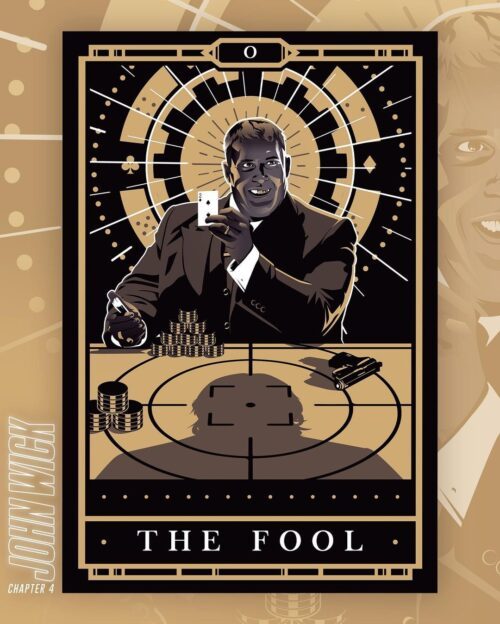
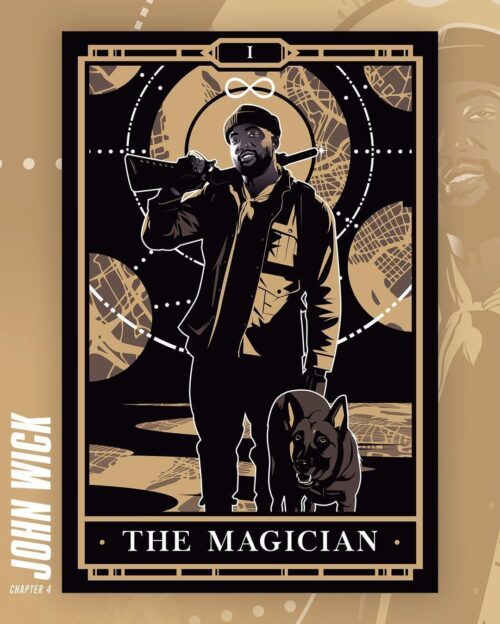
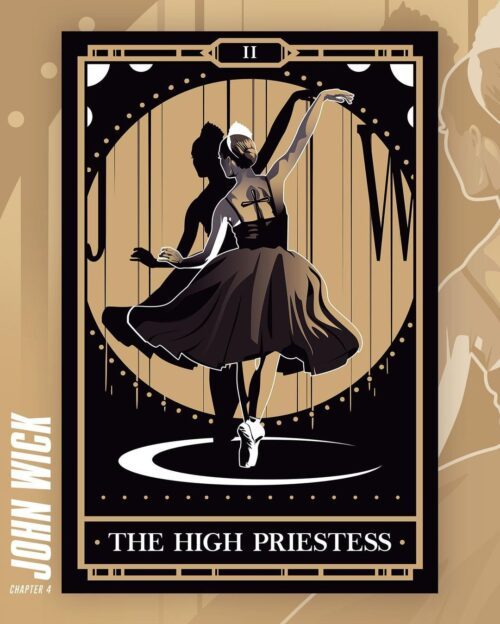


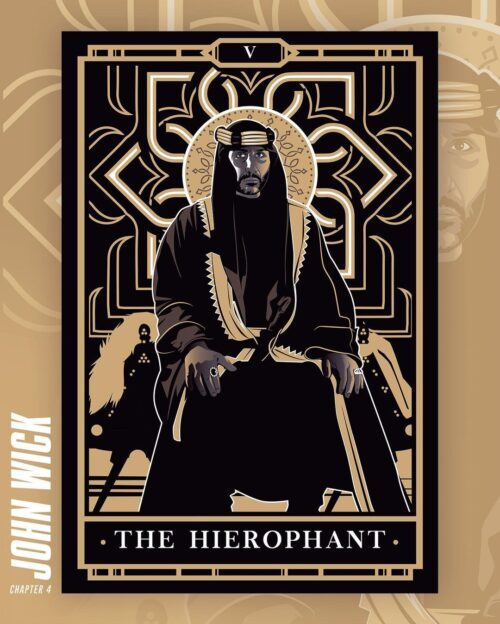

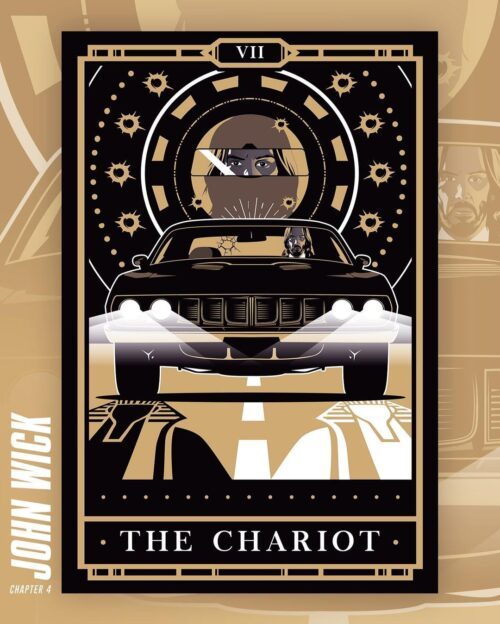


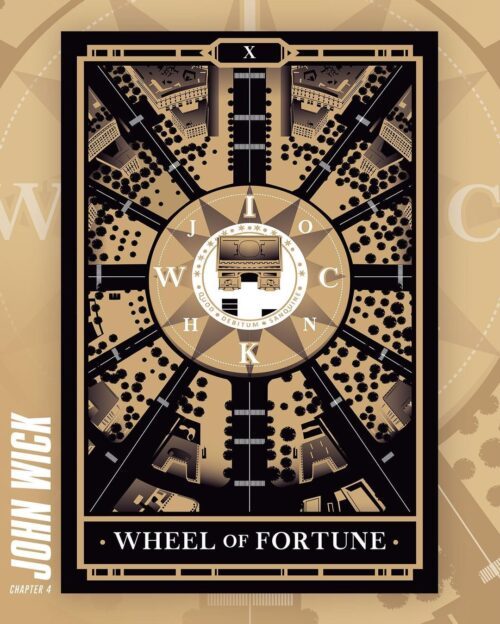

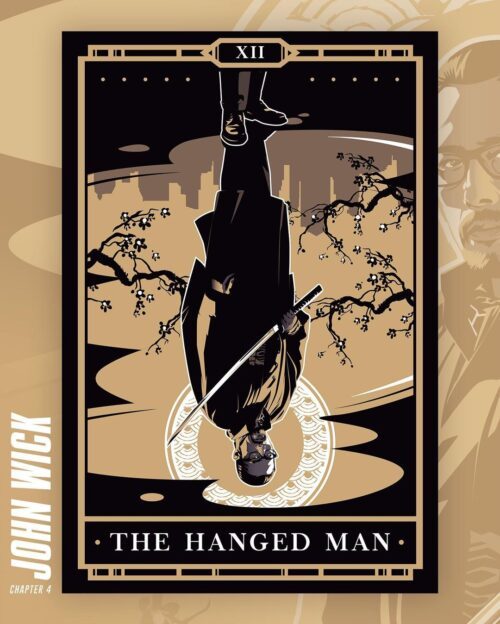
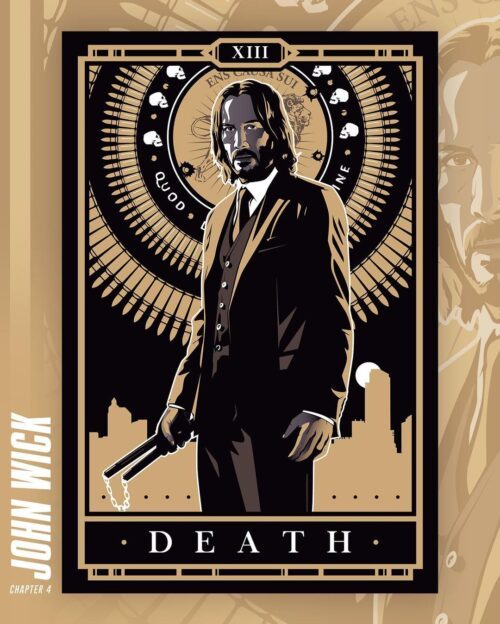
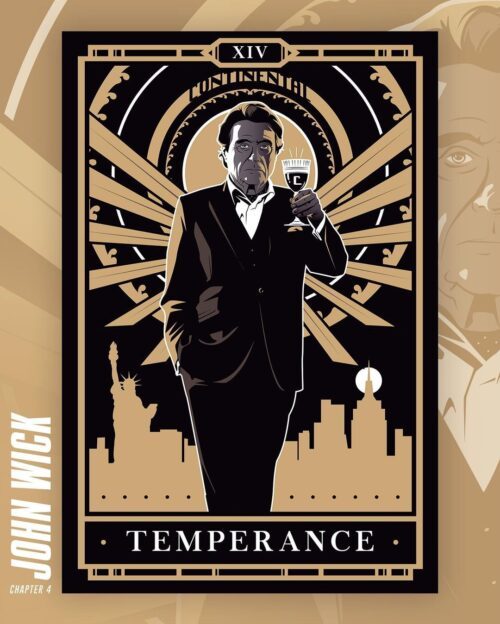

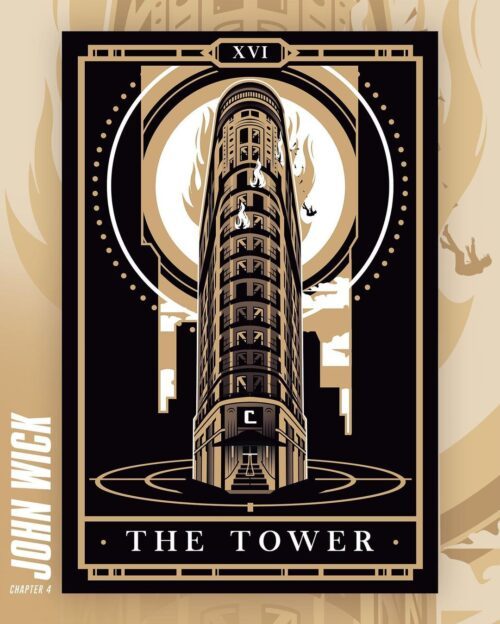

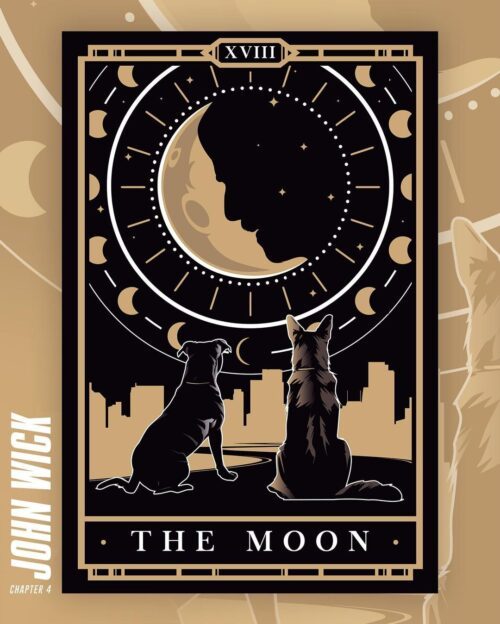

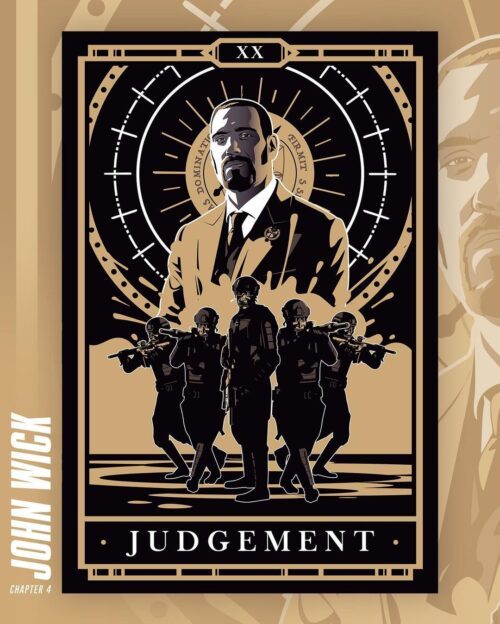

Official John Wick Major Arcana tarot cards featuring Chapter 4 characters
Art by Julien Rico Jr, in collaboration with Lionsgate.
Sources: nerdsloveart, behance
Image descriptions below the cut:
[Start ID: 22 images featuring characters and locations from the movie "John Wick: Chapter 4" as Major Arcana tarot cards. The drawings are in black and white against a sandy beige background, and has plenty of circle motives. Roman numerals are at the top, their corresponding card title at the bottom, and the movie title "John Wick: Chapter 4" on the bottom left margin.
0: The number zero, or unnumbered, tarot card features Killa Harkan played by Scott Adkins as "The Fool". Killa is holding a 2 of spades between two fingers while giving a smug smile that shows off his set of golden teeth. He wears a ring on his right hand and the other hand is holding a stack of cards. Behind Killa is a minimalistic design resembling a casino token with details such as the diamond and clover symbols, as well as the numbers on the dice. In front of Killa is a table with two piling stacks of casino tokens, a gun, and the shadow of John Wick's head looming over a large portion of the table.
1: The number one tarot card features The Tracker or Mr. Nobody played by Shamier Anderson as "The Magician". Mr. Nobody has a smug expression on his face and is holding his rifle in a way that lets it rest slung over his shoulder. By his side is Mr. Nobody's Belgian Malinois. The backdrop consists of simplistic, grayish graphics of map vectors cropped into several circles of different sizes. There is a white-coloured infinity symbol on top of Mr. Nobody's head.
2: The number two tarot card features Rooney, aka The Ballerina, who first appeared in "John Wick: Chapter 3 - Parabellum", as "The High Priestess". Rooney's back is facing towards us as she's performing a ballet move on a circular stage. Rooney is wearing a white crown and a dress that shows the cross tattoo on her back. In the backdrop, where Rooney's face is looking towards, are curtains with the initials "JW" written on the far ends of the frame.
3: The number three tarot card features Katia played by Natalia Tena as "The Empress". With a cool expression on her face, Katia is leaning forward against a set of railings, giving off a domineering aura. Katia is wearing a metallic necklace and a cross on her neck. Behind Katia is the crest of the Ruska Roma and a line in Russian circling around it.
4: The number four tarot card features The Bowery King played by Laurence Fishburne as "The Emperor". The Bowery King is sitting on a throne, but behind him is a pair of eyes staring menacingly at us. In front of him is a logo design with the same pair of eyes, though rendered smaller and appear less menacing, with an X crossed in between and a horizontal line capping the top of the X. At the Bowery King's feet, a few pigeons are shown in the foreground while the Brooklyn Bridge appear in the background.
5: The number five tarot card features The Elder as "The Hierophant". Behind the Elder is an Islamic floral design which extends into a more geometrical pattern. Standing in the background are two of the Elder's men.
6: The number six tarot card features John and Helen Wick, played by Keanu Reeves and Bridget Moynahan, as "The Lovers". John and Helen are smiling brightly towards each other in front of a New York night cityscape backdrop, with the Empire States building separating them at the centre. Above John and Helen is a silhouette of them pressed against each other about to kiss in front of a bright sun with the Brooklyn bridge in the background.
7: The number seven tarot card features John Wick driving his 1971 Plymouth Barracuda as "The Chariot". There is a bullet mark on the front glass pane of John Wick's car. On top is a closeup of John Wick surrounded by a circle of road markings and bullet marks.
8: The number eight tarot card features Charon played by Lance Reddick as "Strength". On top of Charon's head is the infinity symbol, and behind is a design reminiscent of a timepiece neatly decorated with knives, guns and bullets in a circle. Further behind is a faded image of the reverse side of the Gold Coin. Filling the bottom of the frame is the New York cityscape backdrop illuminated by the sun.
9: The number nine tarot card features Caine played by Donnie Yen as "The Hermit". Caine wears sunglasses and is holding a cane in his left hand and a pistol in his right. Caine's head is illuminated by a circle of bright light, which is surrounded by a dimmer, slightly bigger circle with Japanese wave patterns and then large protruding rays of black. In the backdrop are two winding trees along with a city landscape of Osaka, but they are overshadowed by Caine's black rays.
10: The number ten tarot card features L’Arc de Triomphe as "The Wheel of Fortune". The location is illustrated in such a way that looks like a clock, with the monument at the centre and twelve roads leading towards it. Surrounding the Arc de Triomphe are the letters from John Wick's name arranged in the exact order of north-west, north-east, south-west, south-east, west, north, east and south directions.
11: The number eleven tarot card features The Harbinger played by Clancy Brown as "Justice". The whole illustration is framed as if the Harbinger is contained inside an hourglass, with a half-body portrait of the Harbinger at the top and a full-body silhouette of him forming at the bottom from the sand flowing downwards. Behind the Harbinger's portrait is the Latin quote, "si vis pacem, para bellum", whereas next to the Harbinger's silhouette is a crescent moon. Along the sides of the hourglass outside are two duel pistols facing opposite directions on each side.
12: The number twelve tarot card features Koji Shimazu played by Hiroyuki Sanada as "The Hanged Man". Except for his feet, Koji is portrayed as an vertically-inverted reflection of himself on a pool of water. Koji is holding a katana and his head is surrounded by a circle of dim light and a brighter, slightly larger circle made of Japanese wave patterns. As seen in the reflection, behind him are cherry blossom trees and the Osaka city landscape.
13: The number thirteen tarot card features John Wick, aka the Baba Yaga, played by Keanu Reeves as "Death". John Wick is holding a pair of nunchucks in his right hand. Behind John Wick is a city landscape of Osaka lighted by the moon while his head is surrounded by a row of skull pictograms and two rows of bullets. There is also an faded image of the reverse side of the Gold Coin behind John Wick.
14: The number fourteen tarot card features Winston played by Ian McShane as "Temperance". Winston is holding up a wine glass with a capital C labelled on it, and there are multiple swords projecting from his back like wings. Behind Winston is the hotel name "Continental" and numerous halos of various fonts and patterns, along with the cityscape of New York, with the Statue of Liberty and the Empire States building in sight.
15: The number fifteen tarot card features The Marquis, Vincent Bisset de Gramont, played by Bill Skarsgård as "The Devil". Behind the Marquis is his signature emblem with two black knives crossed behind his head. The emblem is surrounded by two rows of knives. In the background is the night cityscape of Paris with the Eiffel Tower in view, illuminated by a moon that is surrounded by a snake or serpent that's chasing its own tail.
16: The number sixteen tarot card features the New York Continental Hotel as "The Tower". The top floors of the Continental Hotel are being set on fire as the small dark silhouette of John Wick and the debris carried along fall from its rooftop.
17: The number seventeen tarot card features Akira played by Rina Sawayama as "The Star". Illuminating behind Akira is a star resembling a six-pointed shuriken with two Japanese stork paintings on its left and right, which is further surrounded by a circle of alternating arrow fletchings and four-pointed shuriken. Akira is holding a bow and arrow and standing tall as the bodies of two men lie dead around her. In the background are the branches of cherry blossom trees and the sun or moon shining behind Akira.
18: The number eighteen tarot card features John Wick's and Mr. Nobody's dogs as "The Moon". The two dogs are staring up at the crescent moon, which is shaped as if John Wick's head is covering portions of the full moon. Surrounding the crescent moon are small stars and a illustration of the cycle of the moon phases. The two dogs are sitting on a road leading into an ambiguous city landscape in the background.
19: The number nineteen tarot card features the Sacré-Coeur as "The Sun". The rays of the sun spread out far and wide as wisps of clouds drifts behind the giant church. A dark silhouette of John Wick can be seen on the top open window of the Sacré-Coeur.
20: The number twenty tarot card features Chidi played by Marko Zaror as "Judgement". Behind Chidi is the emblem of the Marquis with a black knife cutting across behind his head. Below Chidi are the High Table's heavily armoured soldiers who are backdropped by a big splatter of sandy beige.
21: The number twenty-one tarot card features John Wick as "The World". John Wick's back is facing towards us with his head glancing back, showing us his face. Overlayed on top of him is his surname "Wick" with the "I" replaced by a bright silhouette of a walking John Wick. A circle of bullets surrounds John Wick and bullet marks scatter around him as the emblems of the High Table, the Marquis, the Adjudicator, and the Gold Coin fill all four corners of the frame.
./End ID]
#john wick#john wick 4#jw4#john wick chapter 4#keanu reeves#tarot cards#official art#not my art#images#image description#baba yaga#mr nobody#shamier anderson#helen wick#john and helen#caine#caine john wick#donnie yen#koji shimazu#hiroyuki sanada#marquis de gramont#vincent de gramont#bill skarsgård#akira john wick#rina sawayama#scott adkins#ian mcshane#lance reddick#laurence fishburne#clancy brown
259 notes
·
View notes
Text


[ID: First image is a thin crèpe topped with ground 'meat,' herbs, and tomato, and garnished with lemon. Second image is a close-up of the same crèpe with a thick red sauce drizzledover it. End ID
𑐔𑐟𑐵𑑄𑐩𑐬𑐶 / चतांमरि / Chatamari (Newari rice crèpe)
𑐔𑐟𑐵𑑄𑐩𑐬𑐶 / चतांमरि (chatā̃mari), sometimes called "Newari pizza," are rice crèpes made plain or with a savory topping. Chatamari are a popular festival food among the indigenous 𑐣𑐾𑐰𑐵𑑅 / नेवा: (Naivāḥ / Newa) people, most of whom live in the 𑐣𑐾𑐥𑐵𑑅 𑐐𑐵𑑅 / नेपाः गाः (Naipāḥ gāḥ / Nepa Valley) in central Nepal. [1] They are regarded as a near-compulsory addition to the table for holidays including 𑐴𑑂𑐩𑐥𑐸𑐖𑐵 / म्ह पूजा (mha pūjā) and 𑐡𑐶𑐐𑐸 𑐥𑐹𑐖𑐵 / दिगु पू��ा (digu pūjā), when they are served as snacks and appetizers.
A chatamari consists of a thin, fried crèpe, fluffy on the inside and crispy around the edges, and an optional juicy, well-spiced topping. Common toppings are vegetable (with black-eyed peas, potato, and/or soy chunks); meat (with minced chicken or buffalo and tomato); a cracked egg; or some combination thereof. Ginger, garlic, red onion, cumin, turmeric, and sometimes red chili powder and coriander add bite and aroma. To cook chatamari, a thin layer of batter is spread on a tawa, and the batter is topped; the whole is then covered with a clay conical lid and left to steam.
This recipe is for a 𑐎𑐷𑐩𑐵 / कीमा (kīmā; minced meat) chatamari with potato, but you can try replacing the meat substitute with cooked black-eyed peas, replacing the potato with more meat, or replacing the meat and potato with vegetables of your choice (try green peas, julienned carrots, and green onion)—the basic format of this dish is highly customizable.
The Nepali language is increasingly the language of broadcast, education, and even the home, to the detriment of other languages including the Newa language Nepal Bhasa (𑐣𑐾𑐰𑐵𑑅 𑐨𑐵𑐫𑑂 / नेवा: भाय्, nevāḥ bhāy). Scripts historically used to write Nepal Bhasa and Sanskrit have been almost entirely replaced with Devanagari. 𑐥𑑂𑐬𑐔𑐮𑐶𑐟 / प्रचलित (prachalit; lit. "common") was the script used by literate Newa until it began to decline at the turn of the 20th century; the 1960s governmental policy of सांस्कृतिक एकता (Nepali: sā̃skr̥tik ektā; cultural unity) further marginalized it.
Revival efforts have begun, which claim Prachalit (and the ornamental script Ranjana, also used to write Nepal Bhasa and Sanskrit) as parts of Newa identity, and seek to teach them at fairs and in workshops. A process of "ethnicity-building" and identity formation within Nepal, including pushes to use students' mother tongues as the language of instruction (with Devanagari as a "common" script) and to use minoritized languages in television and radio broadcast, have been ongoing since the 1990s.
[1] Terminology is given in Nepal Bhasa unless otherwise specified, in Prachalit followed by Devanagari script. "𑐔𑐟𑐵𑑄𑐩𑐬𑐶," "𑐡𑐶𑐐𑐸 𑐥𑐹𑐖𑐵," and "𑐎𑐷𑐩𑐵" are my transliterations from Devanagari into Prachalit. Latin transliteration is ISO 15919 standard except: "च" ([t͡ʃə]) is rendered "cha" and not "ca." Where two Latin phrases are given, the first is ISO from Devanagari, and the second is the typical English-language spelling or phrase.
Recipe under the cut!
Patreon | Paypal | Venmo
Ingredients
Makes 4 large.
For the topping:
3/4 cup (74g) textured vegetable protein + 1/2 cup (118mL) broth
Or 1 1/2 cup ground beef substitute of choice
1 russet potato (200g) (optional)
2 roma tomatoes, minced or thinly sliced
1 small red onion, minced or thinly sliced
1 green chili, diced or thinly sliced
1/2-inch chunk (5g) ginger, peeled and grated or pounded
2 cloves garlic, grated or pounded
1 tsp ground coriander
1 tsp ground cumin
1 tsp ground turmeric
1 tsp red chili powder (substitute sweet paprika to reduce spice level)
1 tsp meat masala (optional)
2 Tbsp neutral oil (if not including 'egg')
Cilantro, to top
For the egg (optional):
2 Tbsp yellow mung flour or chickpea flour (besan)
1/4 cup coconut milk
1 tsp kala namak (black salt)
You may also use any other egg substitute. This one is inspired by Vietnamese bánh xèo. The coconut milk provides binding and fat; the final topping will not taste of coconut. You may replace it with any neutral oil.
For the batter:
1 1/2 cup (240g) white rice flour
About 1 1/2 cup (350 mL) cool water
Mustard oil, to fry
The chatamari in the photo is served with achar.
Instructions
For the batter:
1. Measure flour into a bowl. Pour in water slowly while whisking until a smooth, pourable batter (the consistency of crèpe batter) forms. Set aside to rest while making the filling.
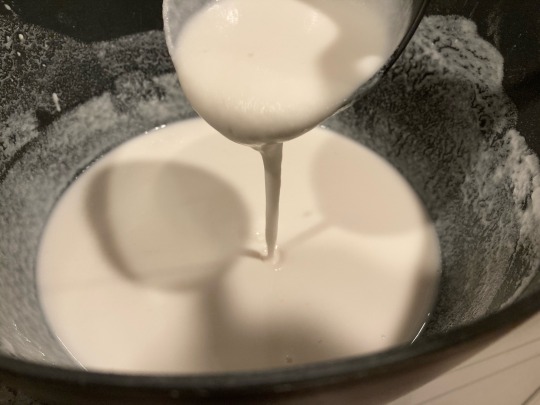
For the filling:
1. Peel and cube potato, then boil until soft. Mash thoroughly with a bean masher or fork.
2. Hydrate TVP in broth or stock (I used water with 1/2 tsp vegetarian beef stock concentrate) for 10 minutes.
3. Mix potato, minced tomatoes and onion, ground 'meat', spices, and 'egg' together in a large mixing bowl until well-combined.
To assemble:
1. Heat a large tawa, comal, or nonstick skillet on medium. Fill a ladle with 100 mL (a bit less than 1/2 cup) of batter, and pour it into the center of the skillet; it should become round on its own. Thin it out a bit with the bottom of the ladle.
2. Cover the top of the batter with the topping, leaving a bit of space on the edge. Optionally, add about 2 tsp of oil around the edges of the chatamari to crisp.
3. Lower the heat to low and cover. Cook for 7 minutes. Remove chatamari onto a plate.
If the rice pancake cracks, your batter is too thin; try resting it, uncovered, for 5-10 minutes, then stirring it and trying again.
4. Raise heat to medium for a minute. Add another ladle of batter, top the chatamari, add oil, lower the heat and cover to cook as before. Repeat until batter or filling runs out.
96 notes
·
View notes
Text
perché il collasso della civiltà occidentale è già in atto ma pochi se ne accorgono?
perché il collasso delle società complesse raramente avviene in questo modo. le società complesse raramente falliscono per un’unica ragione. Possono sopportare un terremoto, la corruzione, l’inflazione, la guerra o la peste, ma non più di uno contemporaneamente.
Ma crollano soprattutto perché non c'è più la volontà di pagare per il suo mantenimento. La maggior parte delle società, come Roma, crollano quando il peso collettivo di tasse, norme e regolamenti, originariamente implementati per migliorare la vita, diventa un peso tale da rendere preferibile il collasso.
Ma paradossalmente il collasso avviene raramente. È un progressivo macinamento, una serie quasi impercettibile di cose che si degradano nel tempo, fino a quando non vengono abbandonate per un bel po' prima che siano completamente non funzionali.
Ecco come si svolse la caduta dell’impero romano d’occidente. A meno che tu non vivessi in una grande città quando fu saccheggiata, potresti quasi immaginare che nulla fosse realmente cambiato nel corso di una generazione. La vita nella tua villa continuava. Ma improvvisamente alcuni beni commerciali cominciarono a diventare difficili da reperire.

Quindi ora sei stato costretto a fare affidamento maggiormente su soluzioni locali e più semplici. Un giorno il tuo sistema idrico fallisce e gli artigiani locali possono solo fare un lavoro da schifo. Quindi ora riempi la tua piscina e la trasformi in un porcile. Ha senso. Puoi quasi convincerti che sia un aggiornamento. Allora quel grande soggiorno con l'elegante pavimento a mosaico ha più senso come stalla. E quando sarai passato davvero al Medioevo, tutti coloro che ricordavano qualcosa di fondamentalmente diverso erano morti da tempo.

Proprio per questo motivo il crollo romano fu così totale, perché fu così graduale. Quando tutto finì, gli edifici e le infrastrutture erano stati cannibalizzati per costruire la pietra, e le persone con il know-how per avviare nuovamente una civiltà avanzata se n'erano andate.

Se a differenza di quello romano, il nostro sembra essere un collasso socialmente forzato, in parte lo è stato anche il loro: ci sono fortune da guadagnare smontando una nazione o un impero, e di solito si guadagna più velocemente che costruendoli. Quindi, una volta che la palla inizia a rotolare non mancano le persone che spingono. Tuttavia è antistorico, cercare la mente che progetta : "fato" e "necessità" come "leggi" quantistiche che governano il mondo, solo dopo viene chi spinge.
44 notes
·
View notes
Text
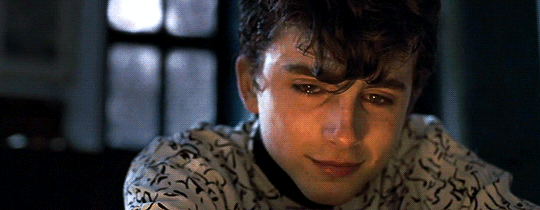
Summary:
By tacit agreement, they’d shelved the more sensitive subjects their thirty minute journey from Roma Termini; postponing grim reality with a wide array of desultory chitchat. The magazines he’ll read on the plane, for example. The meals he’ll be obliged to eat. The inescapable jet lag that’s bound to knock him for six. Denial is grief’s distractor - or so his beloved bubbe used to say - yet such advice itself proves futile as Fiumicino’s glass façade renders him breathless; the gaping wound in Oliver’s torso bleeding ribbons atop the sun-baked parking lot.
“Are you sure you have your passport?”
Elio’s voice is unnervingly blank as he stares out the window of their idling shuttle bus; the lean muscles of his jaw bunched in solemn contrast to the quick-bitten nails tap-tap-tapping his star of David. It’s not the first time he’s asked - nor, Oliver suspects, is he truly heeding his response - but forcing a smile to his frozen features he pats his leather holdall regardless; acutely aware of his livewire knee jerking in the narrow space between them.
By tacit agreement, they’d shelved the more sensitive subjects their thirty minute journey from Roma Termini; postponing grim reality with a wide array of desultory chitchat. The magazines he’ll read on the plane, for example. The meals he’ll be obliged to eat. The inescapable jet lag that’s bound to knock him for six. Denial is grief’s distractor - or so his beloved bubbe used to say - yet such advice itself proves futile as Fiumicino’s glass façade renders him breathless; the gaping wound in Oliver’s torso bleeding ribbons atop the sun-baked parking lot.
It’s all a bit of a blur after that, with Elio offering sporadic translations as they navigate the bustling concourse; both fists jammed in the pockets of his jeans ‘til they’re done checking his bags. Oliver yearns to soothe his pain. To gather him close and never let go. But like a fool, he’s allowed a physical gulf to fester, also. There's no comfort in this phoney shield - no healing from something not properly expressed - and crushed by the weight of their self-imposed exile he’s suddenly struck by the macabre notion their last, frantic kiss at the Pensione Barrett could indeed be just that.
Their last.
And the standard by which all others fall short.
“You’re staring,” Elio mutters, mouth flattened to a hard line, and Oliver’s plagued by indecision as his tell-tale heart beats for the want of another.
“I’m sorry,” he says, half-embarrassed and completely unmoored. “I shouldn’t -”
“Anch’io...” Shuffling his feet, Elio tugs at Billowy’s sleeves where he’s rucked them up to his elbows. “Does it bother you?” A pause. “That I’m wearing it?”
No.
And yes.
Though not in the way he might expect.
The possessive thrill of seeing Elio in his clothes triggers something primal, but given the circumstances, Oliver swallows thickly, a vicious ache rising in his chest as he curses the cards they’ve been dealt.
“What’s mine is yours,” he says eventually, earning a brittle scoff, and the next thing he knows he’s grasping Elio’s wrist like a goddamn lifeline: towing him through the airport pandemonia to the nearest restroom because fuck what anyone else thinks of them.
By some small miracle the long row of cubicles are empty, so Oliver makes a beeline for the furthest stall; throwing the lock then kissing him fiercely, crowding him into the graffiti-covered partition. It comes across too confident when he’s teetering on the brink, but Elio’s body is warm and familiar as he commits each frenzied movement to memory; piecing them back together as Plato envisioned, headless of the one p.m direct flight still waiting to rip them apart.
“I keep telling myself you’re going to change your mind,” Elio whispers, pressing his forehead to the crook of Oliver’s neck. “I keep thinking you’re going to stay.” He doesn’t sound angry. Or even accusatory. Yet the abject resignation in his slumped demeanour strikes a harrowing chord. “Only you’re not, are you,” he continues roughly: less a question than a statement. “When that gate opens -”
“Elio…”
“- you’re just going.”
Unhunching slightly, he clutches the dark-green material of Oliver’s Oxford: a weary Atlas braving the eternal struggle. His palm kneads his shoulder the exact same manner Oliver’s did that afternoon on the tennis court, and the churning of his stomach increases exponentially as Elio lets slip the occasional sniffle over the ancient ceiling fan.
Is it better to speak or die, echoes from the recent past.
You’re hurting me, follows right after.
Scenes from their San Clemente summer play like an old home movie, and the truth is irrefutable as Oliver takes him in his arms; his lover, his soulmate, the sun he’s orbited from the very start.
“Hey…” he murmurs, rocking him gently. “Hey... it’s okay. This isn’t over, yeah? You won’t lose me. Not if I can help it.” There’s a promise beneath his words - an outlandish certainty, likewise - and Oliver hopes with everything he has that Elio hears it also. “I’ll phone. We’ll write. There’s the book tour in the spring…”
Mere crumbs, he’ll admit, to the banquet on which they’re versed, and Elio’s eyes hide nothing as he chews his bottom lip, hands dropping limply to settle at his sides. “Do you have any idea?” he asks then, sans the raw urgency of before. “How glad I am we found each other? How happy I am you came?”
Oliver inhales sharply - allowing himself a choked-up sob - and as a broad, Italian accent booms from the overhead speaker it’s all he can do to hold on tighter: the salty sting of mingled tears bitter upon his tongue.
24 notes
·
View notes
Text
-Immediately feels like Jonathan's "I stayed near the station because I didn't have long between trains" might be a habit learnt from Mina or impressed upon him by Mina, along with his comment on the trains getting less punctual as he goes East. Like he already wishes that he could sit in the square by the station and rokker with her about how this is all very cute but it's hardly Kings Cross, and see what she thinks of the paprika hendl and the handsome peasants etc
- Also oooh the "Cowboy hats and broad leather belts" on the Slovaks sounds a lot like he's also describing the outfits of Roma, specifically the staddi kali as the really iconic thing.
-Interests me that in his enumeration of the peoples of Wallachia, Bukovina, Moldavia and Transylvania he doesn't mention Roma. Though potentially either Jonathan can't recognise them, there aren't any/many in the city, or Bram didn't consider them this early in the narrative. The word that he uses later, "Szgany" is an attempt at rendering the Romanian word "Țigani" which is UNAMBIGUOUSLY an insulting way to refer to Roma.
-So Roma at the time would have been technically emancipated for about 30-ish years in Transylvania, but in practise most of the freed Roma who were forcibly settled would have been still very much under the boot of both landowners and police, with the biggest group who remained nomadic being the Ursari. (How much of this did Bram Stoker know? If he did know it, how much was through the lens of American emancipation movements, which were a big influence on Roma emancipation.)
-I am so happy to have my first letter from my good friend Jonathan! He is having such a lovely holiday in such a beautiful country!
37 notes
·
View notes
Text
Rendering progetto ristrutturazione condominio esterno a Roma




Il nostro studio ha realizzato una serie di rendering esterni progetto ristrutturazione condominio a Roma.
Il nostro servizio di rendering esterni per condomini e palazzine aiuta i professionisti a convincere i committenti ad avviare i loro progetti. Come in questo caso!
#rendering esterni#rendering ristrutturazione condominio#rendering roma#rendering progetto ristrutturazione condominio#rendering condominio
0 notes
Text

#Paulo Dybala#AS Roma#Serie A#Argentina#argentine footballers#football#soccer#Roma FC#Paulo Bruno Exequiel Dybala#transparent png renders
2 notes
·
View notes
Text
Sono andata a scuola con Pamela Mastropietro, la ragazza romana uccisa e smembrata nel 2018.
Mentre scrivo cerco di rendere quello che sento e che ho sentito all’epoca il meno autoreferenziale possibile, eppure mi accorgo che non riesco, ché mi viene da scriverne perché poco fa ho visto un video con la sua faccia dove veniva ripercorsa la vicenda, apprendendo ulteriori scenari, e non riesco perché ogni volta che mi torna in mente lei mi ricordo la sensazione corporea quando ho appreso della sua morta, scorrendo il cellulare, ed ho capito che una ragazza che vedevo fino a dieci giorni prima in classe era stata fatta a pezzi e messa in una valigia. Lo so, è ancora autoreferenziale, ed è il motivo per cui non parlo di questa storia mai - non è la mia, non ne ho il diritto -, anche se mi lacera ancora oggi, ed è forse il motivo per cui non ho mai toccato droghe pesanti in quel periodo orribile.
Io vorrei descrivere Pamela, darne un ritratto fedele, autentico, descrivere il suo accento romano, la sua camminata, il suo atteggiamento duro e spaccone - tranne quando si rivolgeva a me, ché ero fragile all’epoca e forse lei lo aveva capito. Vorrei parlare del rapporto che aveva con la mia professoressa di filosofia, di quanto fosse in gamba, di come parlasse bene, ma non riesco, perché io non sono stata niente per lei, io ero solo una spettatrice, e non posso neanche avere il diritto di sentirmi così dilaniata.
Succede che poco fa apprendo che, prima della sua morte, ben due autisti di taxi hanno consumato un rapporto con lei in cambio di un passaggio per Roma - era appena scappata da una comunità per tossicodipendenti. Solo successivamente ha incontrato lo spacciatore che poi l’ha uccisa, dopo avere abusato di lei. Quando leggo questo io non riesco più neanche a parlare di Pamela, non riesco a dare un ritratto non autoreferenziale della mia angoscia perché mi sale la rabbia cieca e frustrata e senza speranza nel pensare che in quei due giorni ogni figura maschile e adulta incontrata non le abbia teso una mano, non abbia chiamato le autorità, non abbia infierito su quel corpo e quella psiche a pezzi. Aveva 17 anni.
Come si può tollerare una violenza sistemica così atroce? Come si possono tollerare la negligenza e la noncuranza verso una vita così indifesa e fragile? Come non può estendersi, questo fatto, a macchia d’olio, e non farmi salire una rabbia atroce e disperata nei confronti della violenza, della violenza sui deboli - della violenza sulle donne, sempre loro.
Io non lo so come si fa a non mettere la propria sofferenza in mezzo, scusa Pame’, ma ogni tanto m’incazzo; avrei tanto voluto che qualcuno ci fosse stato per te.
20 notes
·
View notes
Note
Do you have any advice on learning how to draw
Romani features?
No. If I've said it once, I've said it a million times, there is no right way for Romani people to look and I would feel enormously uncomfortable to try to ascribe one. My advice to artists is actually the same as my advice to writers, which is that you should put more energy into learning what NOT to do. There is a long history of anti-Romani stereotypes, tropes, and caricatures in Western art and literature. Learning how to identify those and avoid them would be a much more helpful use of your time.
If you're trying to develop a specific character, for example, and you already have a sense of what you want them to look like, then just find pictures of people who look like that and do some studies. There are a lot of tutorials online, that are often quite easy to find, for how to draw specific hair styles, or color and render different skin tones, and so forth. No matter what your art style is, the most important thing any visual artist can do is make a consistent practice of drawing/painting from life or photos, and if there's a subject that you're not familiar with-- including hair types, facial features or skin tones-- doing studies is kind of the only way to get familiar. If you don't have a sense of what you want your character or subject to look like, well, there are plenty of public-facing Romani people in the arts and media that you could look to for reference. Failing that, I guess I would recommend looking at a mixture of South and West Asian references. This is a gross generalization, but that's basically where we came from before arriving in Europe, so it is a decent way to get a sense of what people might look like.
In the last few years, there's been a renewed interest in more inclusive depictions of Romani characters in fandom and media. By and large, I believe this is a good thing, but I also think it's led to an increase in tokenization and a very reductive viewpoint on Roma ethnicity. I talked about it more in this post, but I think people need to develop a better understanding of just how diverse the diaspora is if they want to make informed decisions about what a character "should" look like. But I'll just say this up front, if you're asking me this because you want to draw fanart of Wanda, Pietro, or any of their relatives, just use Dauterman's design sheets. They're perfectly fine. I really like Wanda's nose shape. You could stand to make their skin tones a little darker, but that's really my only note.
9 notes
·
View notes
Text
Da qualche giorno sta facendo rumore (poco, ahime') il "caso Santanche' ", attuale ministra del turismo, sollevato da Report. Tutta la parte politica della ministra si e' schierata a sua difesa facendo notare che, ad oggi, nessun capo di accusa penale e' stato sollevato contro di Lei. Gia'! Quel che conta per certi politici e' la rilevanza penale, quella definitiva, oltretutto, quella che arriva dopo 10anni se tutto va bene. Tutto questo puo' succedere perche' i politici sono lo specchio di una nazione. Un popolo cencioso, arrivista, allergico alle regole, vassallo, profittatore, con un'etica morale e civile quasi pari a zero; sempre pronti alla condanna istantanea quando si tratta di un poveraccio e al massimo garantismo per casta e ricconi... Sono cose che fanno tutti i potenti del Paese, quello di affittare appartamenti enormi al centro di Milano o di Roma intestandoli alle loro societa', cosi da non pagarne nessun costo personale. O comprare panfili da 30 metri o auto da 80mila euro, come fatto dalla ministra. Tutto questo pagato da chi? Dai loro dipendenti e dai loro fornitori, naturalmente. Quelli che lavorano alacremente per l'azienda tra mille sacrifici. Lo stipendio quando c'e' qualche soldo che avanza, la liquidazione alla "campa cavallo" e i fornitori "ma come si permettono a chiedere di essere pagati". Ve lo ricordate il reddito di cittadinanza? "Lo togliamo perche' c'e' qualche furbetto". E allora perche' i politici non fanno leggi societarie per rendere indetraibili certi costi che nulla c'entrano con l'attivita' dell'impresa? Cosa ci deve fare una societa' con lo Yacht? E cosa con una Maserati o una Porche? E un attico vista Duomo o Colosseo? Eppure nessun politico ha mai stigmatizzato certe possibilita' patrimoniali a favore delle societa'. E cosi', anche per questa estate 2023, l'italico popolo si godra' questi panfili che passano davanti ai nostri ombrelloni piantati su qualche spiaggia libera in prossimita' di un canale di scolo acque nere, andando in visibilio ogni qualvolta che un Briatore o una Santanche' qualsiasi si lascera' intravvedere a breve distanza dalla spiaggia mentre brindano a champagne..
@ilpianistasultetto
46 notes
·
View notes
Text

Gilgamesh, the hero king of Uruk. Born from the inter-divine love between the king Lugalbanda and the goddess Ninsun, Gilgamesh was self-described as 2/3rds divine and 1/3rd human. Gilgamesh abused his power once he assumed the throne of Uruk, either enacting slavery or sexually assaulting residents. Watching Gilgamesh’s horrible actions, the sky god Anu created a being called Enkidu who would stop the tyrant. Once Enkidu arrived in Uruk he immediately confronted Gilgamesh, starting an all out brawl across the kingdom. Throwing each other through buildings, their punches created great fissures in the earth. However Gilgamesh barely won out, beating Enkidu. But their fight connected their souls together, the two coming to an ultimate form of love for one another. The two befriended each other, becoming inseparable, and with Enkidu’s influence, Gilgamesh saw the err in his actions, remodeling himself and becoming a valiant ruler. Eventually the pair learn about the monstrous Humbaba, with Gilgamesh proposing that they slay him to both save those he terrorized and to immortalize their actions. The two embark on their journey, receiving a blessing from the sun god Shamash who also wanted to rid Humbaba. The two walked all the way to the cedar forest of the gods, and after finding Humbaba engaged in combat. Their fight shook the earth, but ultimately the two have Humbaba backed into a corner. Gilgamesh attempts to spare the monster’s life, but using underhanded tactics Humbaba tries to backstab Gilgamesh. But with Enkidu alerting him to Humbaba, Gilgamesh is able to defeat Humbaba in one on one combat. The two then gather the great wood from the forest and bring it back to Uruk, where they are celebrated for defeating Humbaba. Seeing his grand feats, the goddess Ishtar appears to Gilgamesh, demanding him to submit himself to her and become one of her lovers. Gilgamesh declines, enraging the goddess who then sends the Bull of heaven to gore Gilgamesh. But the duo of Gilgamesh and Enkidu are able to defeat and kill the grand bull, with Enkidu tearing off a leg and throwing it at Ishtar. The death of the bull stirred among the gods, leading them to conclude that one of the two had to be punished. Enkidu takes on this punishment, his health quickly deteriorating, and ultimately dying. Gilgamesh gathered all of Uruk to mourn Enkidu, though even when they left he still continued. He held Enkidu for so long that he only stopped once maggots began to rise up from Enkidu. Enkidu’s death made Gilgamesh panic over his own mortality, resolving to become immortal like the ferryman of the gods Utnapishtim. Though Gilgamesh was able to best the journey to Utnapishtim, each and every trial and challenge given to him resulted in his failure. Finally after his thorough defeat Gilgamesh realized the limits mortals held, death was inescapable, and hoping to eventually reunite with Enkidu Gilgamesh found solace and accepted death.
The myths of Gilgamesh are the oldest recorded stories found to date, with them originating in Sumerian poetry around 2200BC. More well known ‘Epic of Gilgamesh’ was the result of later Akkadian translations and retellings of the previous Sumerian poetry. The original texts differ from the later Babylonian renditions in many ways, for example Gilgamesh was called the brother of Inanna (the original Sumerian Ishtar) and held a friendly relationship with her. Within this story Gilgamesh and Enkidu help Inanna by driving out the monstrous Anzu and Lilitu from Inanna’s personal garden, even carving a bed and throne for her from the wood of her trees. Inanna rewards Gilgamesh with lavish treasures that he then proceeds to drop into the underworld. Enkidu journeys to the underworld to return the treasure, but ends up being forced to stay in the underworld as his mortal body was rendered dead from the journey. The relationship between Gilgamesh and Enkidu holds clear homosexual connotations, the two often preforming traditional romantic gestures during their journeys as well as describing their relationship as ‘like a man and wife’. Several ancient poems have also recorded certain potential euphemisms used in stories about Enkidu and Gilgamesh’s exploits. Some have refuted this however, stating that it’s purely metaphorical. Gilgamesh was worshiped as a deity in Sumer, especially among Sumerian kings. These kings would call Gilgamesh their friend and brother, even declaring themselves the children of Lugalbanda and Ninsun. According to Ancient Greek writings, Gilgamesh’s mother was locked away and kept under guard by his grandfather, this was because the grandfather had received a prophecy that his grandson would depose him. When his mother ended up pregnant they threw the baby Gilgamesh out of the building, but he was saved by an eagle who delivered him to a gardener. It’s sufficed to say that this origin was never believed by the ancient Mesopotamians and was likely a Greek invention.
#art#character design#mythology#mesopitamian mythology#mesopotamia#sumerian mythology#sumer#akkad#babylonian mythology#babylon#gilgamesh#culture hero#strength god#the epic of gilgamesh
5 notes
·
View notes